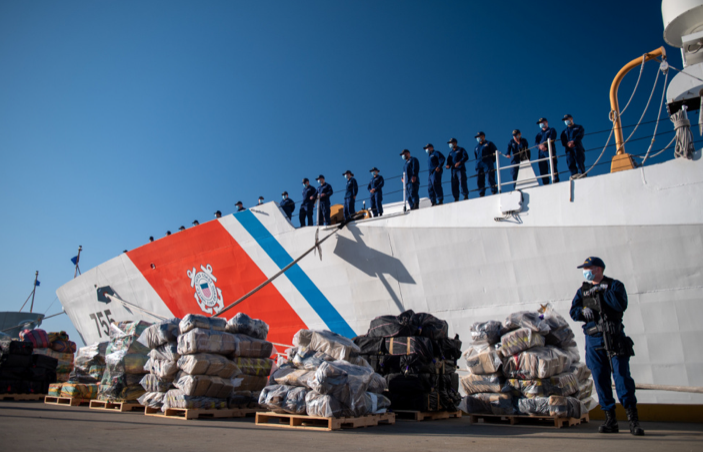Prior to the Munro’s arrival in Alameda, the crew transferred 12 detainees, approximately 9,200 lbs. of cocaine and 2,150 lbs. of marijuana to law enforcement officials in San Diego.
The drugs, in total worth an estimated $330 million, were seized in international waters of the Eastern Pacific Ocean between January and March, representing 15 suspected drug smuggling vessel interdictions off the coasts of Mexico, Central and South America by the following Coast Guard and Navy ships:
- The Coast Guard cutter Munro (WMSL 755) crew was responsible for nine interdictions, seizing approximately 10,200 pounds of cocaine and 11,450 lbs. of marijuana.
- The Coast Guard cutter Bear (WMEC 901) crew was responsible for two interdictions, seizing approximately 66 lbs. of cocaine.
- The Coast Guard cutter Vigilant (WMEC 617) crew was responsible for one interdiction, seizing approximately 1,870 lbs. of cocaine.
- The Coast Guard cutters Bear and Munro conducted a joint interdiction, seizing approximately 3,747 lbs. of cocaine.
- Coast Guard Law Enforcement Detachment 107 deployed aboard the USS Freedom (LCS 1) was responsible for two interdictions, seizing approximately 1,600 lbs. of cocaine and 2,150 pounds of marijuana.
“National security cutters like Munro are national-level assets and are game changers for the United States government’s maritime interdiction capability,” Vice Adm. Linda Fagan, the commander of Coast Guard Pacific Area, said in a statement. “As your Coast Guard, we use our unique capabilities and authorities as a military service and a law enforcement agency to secure the nation’s maritime border and to disrupt illegal activity of dangerous cartels. This offload demonstrates another successful cycle of justice.”
"Transnational criminal organizations have not slowed down due to the pandemic, and the Coast Guard women and men continue to protect our nation on the frontlines,” said Capt. Blake Novak, the commanding officer of the Munro. “Our crew intercepted a group of suspected smugglers, on average, every 90 hours for 45 days straight, seizing nearly 30,000 pounds of cocaine and marijuana valued at over $330 million. Maintaining such a high level of performance was only possible because of a total team effort. This crew set the bar for excellence, and I am incredibly proud of all of them."
On April 1, 2020, U.S. Southern Command increased counter-narcotics operations in the Western Hemisphere to disrupt the flow of drugs. Numerous U.S. agencies from the Departments of Defense, Justice, and Homeland Security cooperated in the effort to combat transnational organized crime. The Coast Guard, Navy, Customs and Border Protection, FBI, Drug Enforcement Administration, and Immigration and Customs Enforcement, along with allied and international partner agencies, play a role in counter-drug operations.
The fight against drug cartels in the Eastern Pacific Ocean requires unity of effort in all phases from detection, monitoring, and interdictions, to criminal prosecutions by international partners and U.S. Attorneys’ Offices in districts across the nation.
The law enforcement phase of counter-smuggling operations in the Eastern Pacific Ocean is conducted under the authority of the 11th Coast Guard District, headquartered in Alameda. The interdictions, including the actual boardings, are led and conducted by members of the U.S. Coast Guard.




